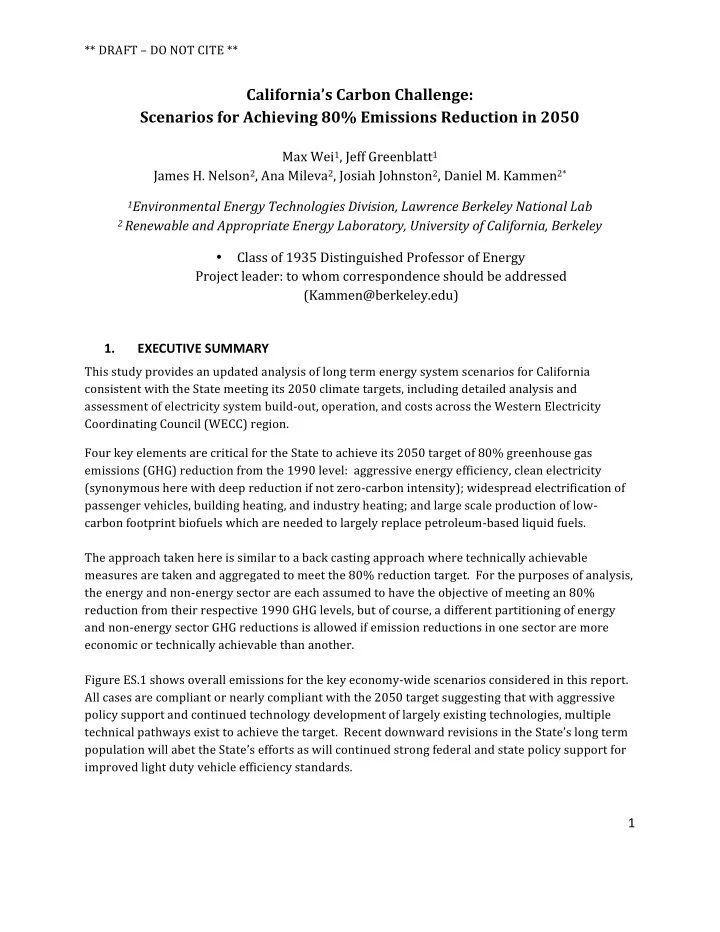

** ¡DRAFT ¡– ¡DO ¡NOT ¡CITE ¡** ¡ California’s ¡Carbon ¡Challenge: ¡ Scenarios ¡for ¡Achieving ¡80% ¡Emissions ¡Reduction ¡in ¡2050 ¡ ¡ Max ¡Wei 1 , ¡Jeff ¡Greenblatt 1 ¡ James ¡H. ¡Nelson 2 , ¡Ana ¡Mileva 2 , ¡Josiah ¡Johnston 2 , ¡Daniel ¡M. ¡Kammen 2* ¡ 1 Environmental ¡Energy ¡Technologies ¡Division, ¡Lawrence ¡Berkeley ¡National ¡Lab ¡ 2 ¡ Renewable ¡and ¡Appropriate ¡Energy ¡Laboratory, ¡University ¡of ¡California, ¡Berkeley ¡ • Class ¡of ¡1935 ¡Distinguished ¡Professor ¡of ¡Energy ¡ Project ¡leader: ¡to ¡whom ¡correspondence ¡should ¡be ¡addressed ¡ (Kammen@berkeley.edu) ¡ ¡ 1. EXECUTIVE ¡SUMMARY ¡ This ¡study ¡provides ¡an ¡updated ¡analysis ¡of ¡long ¡term ¡energy ¡system ¡scenarios ¡for ¡California ¡ consistent ¡with ¡the ¡State ¡meeting ¡its ¡2050 ¡climate ¡targets, ¡including ¡detailed ¡analysis ¡and ¡ assessment ¡of ¡electricity ¡system ¡build-‑out, ¡operation, ¡and ¡costs ¡across ¡the ¡Western ¡Electricity ¡ Coordinating ¡Council ¡(WECC) ¡region. ¡ ¡ ¡ Four ¡key ¡elements ¡are ¡critical ¡for ¡the ¡State ¡to ¡achieve ¡its ¡2050 ¡target ¡of ¡80% ¡greenhouse ¡gas ¡ emissions ¡(GHG) ¡reduction ¡from ¡the ¡1990 ¡level: ¡ ¡aggressive ¡energy ¡efficiency, ¡clean ¡electricity ¡ (synonymous ¡here ¡with ¡deep ¡reduction ¡if ¡not ¡zero-‑carbon ¡intensity); ¡widespread ¡electrification ¡of ¡ passenger ¡vehicles, ¡building ¡heating, ¡and ¡industry ¡heating; ¡and ¡large ¡scale ¡production ¡of ¡low-‑ carbon ¡footprint ¡biofuels ¡which ¡are ¡needed ¡to ¡largely ¡replace ¡petroleum-‑based ¡liquid ¡fuels. ¡ ¡ ¡ ¡ The ¡approach ¡taken ¡here ¡is ¡similar ¡to ¡a ¡back ¡casting ¡approach ¡where ¡technically ¡achievable ¡ measures ¡are ¡taken ¡and ¡aggregated ¡to ¡meet ¡the ¡80% ¡reduction ¡target. ¡ ¡For ¡the ¡purposes ¡of ¡analysis, ¡ the ¡energy ¡and ¡non-‑energy ¡sector ¡are ¡each ¡assumed ¡to ¡have ¡the ¡objective ¡of ¡meeting ¡an ¡80% ¡ reduction ¡from ¡their ¡respective ¡1990 ¡GHG ¡levels, ¡but ¡of ¡course, ¡a ¡different ¡partitioning ¡of ¡energy ¡ and ¡non-‑energy ¡sector ¡GHG ¡reductions ¡is ¡allowed ¡if ¡emission ¡reductions ¡in ¡one ¡sector ¡are ¡more ¡ economic ¡or ¡technically ¡achievable ¡than ¡another. ¡ ¡ Figure ¡ES.1 ¡shows ¡overall ¡emissions ¡for ¡the ¡key ¡economy-‑wide ¡scenarios ¡considered ¡in ¡this ¡report. ¡ ¡ All ¡cases ¡are ¡compliant ¡or ¡nearly ¡compliant ¡with ¡the ¡2050 ¡target ¡suggesting ¡that ¡with ¡aggressive ¡ policy ¡support ¡and ¡continued ¡technology ¡development ¡of ¡largely ¡existing ¡technologies, ¡multiple ¡ technical ¡pathways ¡exist ¡to ¡achieve ¡the ¡target. ¡ ¡Recent ¡downward ¡revisions ¡in ¡the ¡State’s ¡long ¡term ¡ population ¡will ¡abet ¡the ¡State’s ¡efforts ¡as ¡will ¡continued ¡strong ¡federal ¡and ¡state ¡policy ¡support ¡for ¡ improved ¡light ¡duty ¡vehicle ¡efficiency ¡standards. ¡ ¡ ¡ ¡ 1 ¡ ¡ ¡
** ¡DRAFT ¡– ¡DO ¡NOT ¡CITE ¡** ¡ Figure ¡ES2 ¡shows ¡the ¡progression ¡of ¡energy-‑sector ¡GHG ¡reductions ¡by ¡key ¡element ¡(efficiency, ¡ clean ¡electricity, ¡electrification, ¡etc.) ¡starting ¡from ¡a ¡business ¡as ¡usual ¡(BAU) 1 ¡case ¡to ¡the ¡Base ¡Case, ¡ while ¡Figure ¡ES3 ¡shows ¡the ¡percentage ¡contribution ¡to ¡GHG ¡savings ¡by ¡sector ¡and ¡key ¡element. ¡ Transportation ¡efficiency, ¡clean ¡electricity, ¡and ¡electrification ¡are ¡seen ¡to ¡be ¡the ¡largest ¡levers ¡with ¡ almost ¡50% ¡of ¡energy-‑sector ¡GHG ¡reduction ¡from ¡the ¡transportation ¡sector. ¡ ¡ ¡ ¡ ¡ This ¡work ¡also ¡considers ¡detailed ¡sensitivity ¡analysis ¡for ¡the ¡base ¡compliant ¡case ¡(Figure ¡ES4) ¡ providing ¡quantification ¡on ¡the ¡impact ¡of ¡partial ¡or ¡more ¡aggressive ¡implementation ¡of ¡efficiency, ¡ light ¡duty ¡electrification, ¡building ¡and ¡industry ¡electrification ¡and ¡other ¡key ¡factors. ¡ ¡In ¡addition ¡to ¡ the ¡large ¡role ¡for ¡transportation ¡efficiency, ¡key ¡hinge ¡factors ¡for ¡the ¡State ¡include: ¡the ¡amount ¡of ¡ imported ¡low ¡carbon ¡biofuels, ¡the ¡degree ¡to ¡which ¡the ¡electricity ¡system ¡is ¡decarbonized, ¡and ¡the ¡ amount ¡of ¡building ¡and ¡industry ¡electrification. ¡ ¡For ¡example, ¡if ¡any ¡one ¡of ¡these ¡elements ¡“falters” ¡ and ¡does ¡not ¡achieve ¡the ¡GHG ¡reduction ¡amount ¡assumed ¡in ¡the ¡base ¡case, ¡energy ¡system ¡emissions ¡ can ¡increase ¡by ¡more ¡than ¡40% ¡over ¡the ¡target ¡level ¡(or ¡from ¡77Mt ¡to ¡about ¡110Mt). ¡ ¡ The ¡critical ¡role ¡of ¡developing ¡a ¡robust ¡and ¡cost-‑effective ¡clean ¡electricity ¡supply ¡system ¡is ¡also ¡ highlighted. ¡ ¡Clean ¡electricity ¡enables ¡a ¡decarbonization ¡path ¡in ¡the ¡building ¡sector ¡through ¡ electrified ¡heating ¡(e.g., ¡heat ¡pump-‑based ¡water ¡and ¡space ¡heating) ¡and ¡through ¡the ¡electrification ¡ of ¡building ¡heating ¡it ¡also ¡enables ¡GHG-‑compliance ¡even ¡with ¡a ¡reduced ¡level ¡of ¡building ¡shell ¡and ¡ insulation ¡measures ¡(Reduced ¡or ¡50% ¡energy ¡efficiency ¡case ¡in ¡Figure ¡ES1). ¡ ¡This ¡reduced ¡ efficiency ¡case ¡assumes ¡both ¡clean ¡electricity ¡and ¡electrified ¡building ¡heating, ¡and ¡if ¡either ¡of ¡these ¡ measures ¡is ¡not ¡in ¡place, ¡emissions ¡would ¡increase ¡by ¡about ¡50% ¡(Figure ¡ES4). ¡ ¡ ¡ ¡ ¡ ¡ ¡ ¡ ¡ ¡ ¡ ¡ ¡ ¡ ¡ ¡ ¡ ¡ ¡ ¡ ¡ ¡ ¡ ¡ ¡ ¡ ¡ ¡ ¡ ¡ ¡ ¡ ¡ ¡ ¡ ¡ ¡ ¡ ¡ ¡ ¡ ¡ ¡ ¡ ¡ ¡ ¡ ¡ ¡ ¡ ¡ ¡ ¡ ¡ ¡ ¡ ¡ ¡ ¡ ¡ ¡ ¡ ¡ ¡ ¡ 1 ¡BAU ¡refers ¡to ¡the ¡case ¡where ¡existing ¡efficiency ¡levels ¡for ¡end ¡uses ¡such ¡as ¡appliances ¡and ¡vehicles ¡are ¡ frozen ¡at ¡current ¡levels. ¡ ¡ ¡ 2 ¡ ¡ ¡
** ¡DRAFT ¡– ¡DO ¡NOT ¡CITE ¡** ¡ 100 90 80 GHG ¡[Mt ¡CO 2 -‑eq] 70 60 Non-‑Energy ¡ 50 Emissions 40 30 Energy ¡Emissions 20 10 2050 ¡CARB ¡Target 0 ¡ Figure ¡ES.1. ¡Overall ¡GHG ¡emissions ¡for ¡scenarios ¡in ¡this ¡report. ¡ ¡All ¡cases ¡are ¡compliant ¡or ¡nearly ¡ compliant ¡with ¡the ¡2050 ¡target ¡(the ¡-‑20% ¡carbon ¡cap ¡electricity ¡case ¡is ¡within ¡1Mt ¡of ¡overall ¡85Mt ¡ CO 2 -‑eq ¡target ¡and ¡others ¡are ¡at ¡or ¡below ¡it). ¡ 350 2050 ¡GHG ¡ Emissions [Mt ¡CO 2 -‑eq] 300 Efficiency 250 Clean ¡Electricity 200 Electrification 150 Biofuels 100 50 Oil-‑Gas ¡Industry ¡ Replacement 0 Remaining ¡GHG, ¡ 2050 ¡ Figure ¡ES.2. ¡Progression ¡of ¡energy-‑sector ¡GHG ¡savings ¡in ¡2050 ¡from ¡the ¡BAU ¡case ¡to ¡the ¡base ¡case. ¡ ¡ Total ¡energy-‑sector ¡emissions ¡in ¡2050 ¡for ¡the ¡resultant ¡base ¡case ¡is ¡75Mt ¡CO 2 eq. ¡ ¡ ¡ 3 ¡ ¡ ¡
Recommend
More recommend